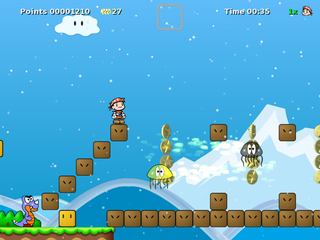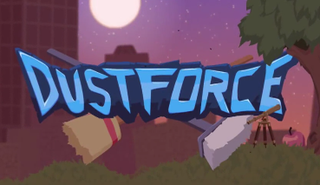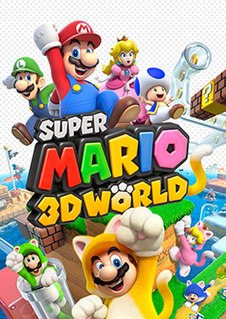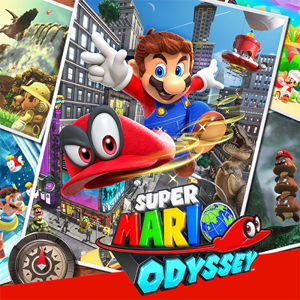
Super Mario Kart is a kart racing video game developed and published by Nintendo for the Super Nintendo Entertainment System. The first game of the Mario Kart series, it was released in Japan and North America in 1992, and in Europe the following year in 1993. Selling 8.76 million copies worldwide, the game went on to become the fourth best-selling SNES game of all time. Super Mario Kart was re-released on the Wii's Virtual Console in 2009, on the Wii U's Virtual Console in 2013, and on the New Nintendo 3DS's Virtual Console in 2016. Nintendo re-released Super Mario Kart in 2017 as part of the company's Super NES Classic Edition.
A platform game is a sub-genre of action video games in which the core objective is to move the player character between points in an environment. Platform games are characterized by levels consisting of uneven terrain and suspended platforms of varying height that require jumping and climbing to traverse. Other acrobatic maneuvers may factor into the gameplay, such as swinging from vines or grappling hooks, jumping off walls, air dashing, gliding through the air, being shot from cannons, or bouncing from springboards or trampolines. Games where jumping is automated completely, such as 3D games in The Legend of Zelda series, fall outside of the genre.

Super Mario World 2: Yoshi's Island is a 1995 platform game developed and published by Nintendo for the Super Nintendo Entertainment System (SNES). The player controls Yoshi, a friendly dinosaur, on a quest to reunite baby Mario with his brother Luigi, who has been kidnapped by Kamek. As a Super Mario series platformer, Yoshi runs and jumps to reach the end of the level while solving puzzles and collecting items with Mario's help. The game has a hand-drawn aesthetic and was the first in the franchise to have Yoshi as its main character, where it introduces his signature flutter jump and egg spawning abilities.

Super Mario Bros.: The Lost Levels is a 1986 platform game developed and published by Nintendo as the sequel to Super Mario Bros. (1985). The games are similar in style and gameplay, with players controlling Mario or Luigi to rescue Princess Peach from Bowser. The Lost Levels adds a greater level of difficulty and Luigi controls slightly differently from Mario, with reduced ground friction and increased jump height. The Lost Levels also introduces obstacles such as poison mushroom power-ups, counterproductive level warps, and mid-air wind gusts. The game has 32 levels across eight worlds and 20 bonus levels.

Super Mario Sunshine is a 2002 platform game developed and published by Nintendo for the GameCube. It is the second 3D game in the Super Mario series, following Super Mario 64 (1996). The game was directed by Yoshiaki Koizumi and Kenta Usui, produced by series creators Shigeru Miyamoto and Takashi Tezuka, written by Makoto Wada, and scored by Koji Kondo and Shinobu Tanaka.

A side-scrolling video game, sometimes shortened to side-scroller, is a game in which the action is viewed from a side-view camera angle and the screen follows the player as they move left or right. The jump from single-screen or flip-screen graphics to scrolling graphics during the golden age of arcade games was a pivotal leap in game design, comparable to the move to 3D graphics during the fifth generation.

Super Mario is a platform game series created by Nintendo starring their mascot, Mario. Alternatively called the Super Mario Bros. series or simply the Mario series, it is the central series of the greater Mario franchise. At least one Super Mario game has been released for every major Nintendo video game console. There are more than 20 games in the series.

Super Meat Boy is a 2010 platform game designed by Edmund McMillen and Tommy Refenes under the collective name of "Team Meat". It was self-published as the successor to Meat Boy, a 2008 flash game designed by McMillen and Jonathan McEntee. In the game, the player controls Meat Boy, a red, cube-shaped character, as he attempts to rescue his girlfriend, Bandage Girl, from the game's antagonist Dr. Fetus. The gameplay is characterized by fine control and split-second timing, as the player runs and jumps through over 300 hazardous levels while avoiding obstacles. The game also supports the creation of player-created levels. Super Meat Boy was first released on the Xbox 360 through Xbox Live Arcade in October 2010, and was later ported to Microsoft Windows, OS X, Linux, PlayStation 4, PlayStation Vita, Wii U, and the Nintendo Switch. A Wii version was in development, but ultimately cancelled.

Mario is a media franchise, produced and published by video game company Nintendo, created by Japanese game designer Shigeru Miyamoto and starring the fictional character Mario. It is primarily a video game franchise, but has extended to other forms of media, including television series, comic books, a 1993 feature film and theme park attractions. The series' first installment was 1983's Mario Bros., although Mario had made his first appearance in 1981's Donkey Kong, and had already been featured in several games of the Donkey Kong and Game & Watch series. The Mario games have been developed by a variety of developers including Nintendo, Hudson Soft, and AlphaDream. Most Mario games have been released exclusively for Nintendo's various video game consoles and handhelds, from the third generation onward.
Nintendocore is a broadly defined style of metal music that most commonly fuses chiptune and video game music with hardcore punk and/or heavy metal. The genre is sometimes considered a direct subgenre of post-hardcore and a fusion genre between metalcore and chiptune. The genre originated in the early 2000s and peaked around the late 2000s with bands like Horse the Band, An Albatross, The NESkimos and Minibosses pioneering the genre.

Mighty Jill Off is a 2008 independently developed freeware platform video game designed by Anna Anthropy, with art by James Harvey and music by Andrew Toups. It stars a submissive named Jill, who has a boot fetish and is forced to climb up a tower after her Queen kicks her down it as punishment. Jill does this by jumping and slowly descending over obstacles. Jill can be defeated in one hit by these obstacles, but will return to the last check point. The game serves as an homage to the 1984 arcade game Bomb Jack and its console and computer sequel, Mighty Bomb Jack. It had follow-ups, such as Mighty Jill Off - Jill Off Harder Edition and Jill Off With One Hand. Jill made a cameo appearance in the 2010 video game Super Meat Boy as a playable character.

Dustforce is a platform video game developed by Hitbox Team. The game was released in January 2012 for Microsoft Windows via Steam, and Mac OS X through Steam in May 2012. A Linux port was released as part of the Humble Indie Bundle 6. Capcom published the game for the PlayStation 3, PlayStation Vita, and Xbox 360.

Super Mario 3D World is a platform game developed and published by Nintendo for the Wii U in 2013. It is the sixth original 3D platform game in the Super Mario series and the sequel to Super Mario 3D Land (2011) for the Nintendo 3DS. The game follows Mario and friends attempting to rescue fairy-like creatures called Sprixies from Bowser, who invades the realm known as the Sprixie Kingdom. The gameplay is similar to previous installments of the series, with players passing through individual levels to reach Bowser. The game features a character selector as well as introducing a power-up called the Super Bell, which turns the player into a cat, enabling them to climb walls and use a scratch attack. Super Mario 3D World + Bowser's Fury, an enhanced port bundled with the game Bowser's Fury, was released for the Nintendo Switch on February 12, 2021.

Captain Toad: Treasure Tracker is a 2014 action puzzle video game developed and published by Nintendo for the Wii U. It is a spin-off of the Super Mario series which builds upon the isometric minigames starring Captain Toad from Super Mario 3D World.

A kart racing game, also known as cart racing game or go-kart racing game, is a subgenre of racing video games. Kart racing games have simplified driving mechanics while including unusual racetrack designs, obstacles, and vehicular combat. Though the genre has its roots in the 1980s, Super Mario Kart (1992) popularized the genre, with the Mario Kart series still being considered the foremost kart racing franchise.
"Nintendo hard" refers to extreme difficulty in video games, characterized by trial-and-error gameplay and limited or nonexistent saving of progress. It originated with the Nintendo Entertainment System in the 1980s and 1990s, such as with Contra (1988), Ninja Gaiden (1988), and Battletoads (1991). Its usage has continued since.

Super Mario Odyssey is a 2017 action-adventure platform game developed and published by Nintendo for the Nintendo Switch video game console. An entry in the Super Mario series, it follows Mario and his new ally Cappy—a sentient hat that allows Mario to control other characters and objects—as they journey across various kingdoms to save Princess Peach from his nemesis Bowser's plans of forced marriage. In contrast to the linear gameplay of prior entries, the game returns to the primarily open-ended, 3D platform gameplay featured in Super Mario 64 and Super Mario Sunshine. Odyssey was released on October 27, 2017.

The King's Bird is a platformer developed by American indie game studio Serenity Forge and published by Canadian indie game publisher Graffiti Games. The game was developed in Unity and released for Microsoft Windows on August 23, 2018. The game was presented at PAX East 2018 and the E3 Media Indie Exchange.

A platform fighter is a subgenre of fighting games that cover games that emphasize fighting on stages with free 2D movement, similar to a platform game.













